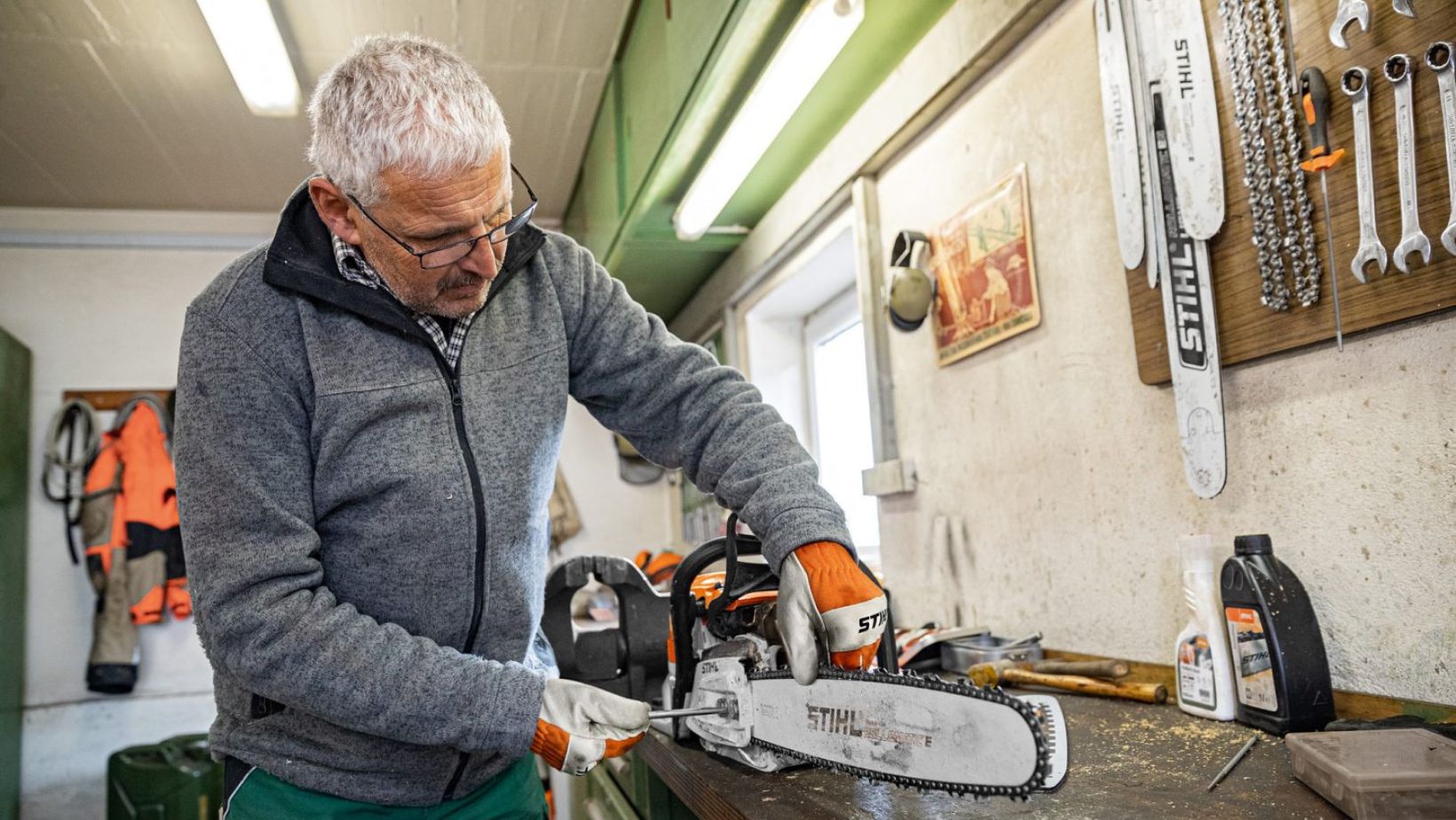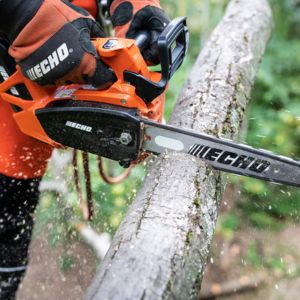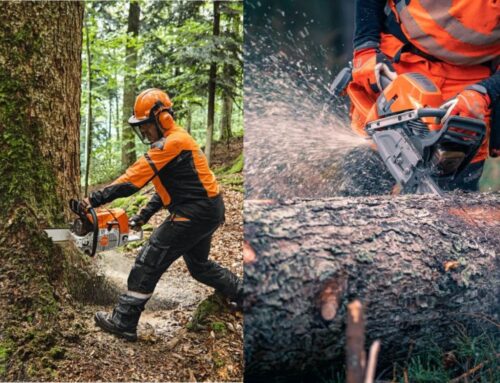
How Do You Tighten a Chain On a Chainsaw?
One of the most important chainsaw maintenance tasks any chainsaw operator has to carry out is tensioning the chain. This means ensuring that it is fitted correctly around the chainsaw’s guide bar – tight enough to remain secure but with enough slack to move freely.
Here, we explain exactly why a chainsaw chain needs tensioning. We then reveal when you should check the chain tensioning and carry out any adjustments. Finally, we’ll show you how to tighten chainsaw chain in 7 straightforward steps.
So, if you’re wondering how to tighten a chain on a STIHL chainsaw or how to tighten a Husqvarna chainsaw chain (as well as other brands), please read on…
Why Does a Chainsaw Chain Need Properly Tensioning?
Correctly tensioning your chainsaw’s chain helps optimise the chainsaw’s performance, keeps you safe when you’re operating it, and prolongs the life of the tool.
 If the chain is too loose, then it risks derailing – in other words, coming off the chainsaw. Not only is derailment likely to damage your chainsaw and the object that it’s cutting, it could potentially cause serious injury to you and any bystanders too.
If the chain is too loose, then it risks derailing – in other words, coming off the chainsaw. Not only is derailment likely to damage your chainsaw and the object that it’s cutting, it could potentially cause serious injury to you and any bystanders too.
On the other hand, if the chain is tensioned too tightly, this can damage the chain, as well as putting excessive pressure on the guide bar, sprocket and motor. This will reduce your chainsaw’s effectiveness, accelerate wear and tear on key parts, and end up damaging the chainsaw.
Ultimately, correctly tightening chainsaw chain is all about striking the right balance by finding the optimum level of tension.
How Tight Should Your Chainsaw Chain Be?
So, if you’re asking yourself exactly how tight should my chainsaw chain be, the answer is that there isn’t just one standard chainsaw chain tension setting. Rather, there is a range of acceptable tension levels, which is often dependent on the task in hand. For example, if you are cutting a harder wood, like oak, you might need a slightly tighter chain than normal to keep your cutting precise.
In terms of specific recommendations for your chainsaw, always be guided by the chainsaw’s instruction manual, which will show you how to adjust chainsaw tension correctly for the model you own. The reason is that all chainsaws are designed with their own tensioning requirements.
When Should You Check a Chainsaw’s Chain Tensioning?
Chainsaw chains are at their most susceptible to stretching when they are brand new, so you’ll need to tighten the chain more frequently after first buying the tool.
 From then on, there are a range of factors that can affect your chainsaw’s chain tension. These include how frequently you use the chainsaw, what you are cutting, whether you encounter obstructions, weather conditions, oil lubrication levels, and the thoroughness of your chainsaw maintenance schedule.
From then on, there are a range of factors that can affect your chainsaw’s chain tension. These include how frequently you use the chainsaw, what you are cutting, whether you encounter obstructions, weather conditions, oil lubrication levels, and the thoroughness of your chainsaw maintenance schedule.
In fact, a chainsaw’s chain can potentially loosen whenever you have used the tool, which is why we recommend checking the tension before all of your chainsaw jobs.
When Not to Check a Saw Chain’s Tension
That said, we don’t advise checking the chain’s tension straight AFTER using your chainsaw, when it is still at operating temperature. Not only do you risk burning yourself on hot parts of the chainsaw, you will also create unnecessary work for yourself.
This is because the saw chain heats up and expands when it’s in use, so if you increase the chain’s tension (tighten it) while it’s still at operating temperature, you will then need to reduce the tension (loosen the chain) again once it’s cooled down.
How Do You Tighten a Chainsaw Chain?
Your chainsaw’s tensioning device will either be a simple adjustment wheel, which you can just grip and turn, or a screw that’s tightened with a chainsaw tightening tool. While this adjustment mechanism is front mounted on some chainsaws, it is usually side mounted on newer models.
 Regardless of how you access the adjustment mechanism, and whether or not it requires a tool, the principle behind tensioning a chainsaw’s chain remains the same.
Regardless of how you access the adjustment mechanism, and whether or not it requires a tool, the principle behind tensioning a chainsaw’s chain remains the same.
So, here is our straightforward step-by-step guide showing how to tighten a chainsaw…
Our 7-Step Guide
1) The first thing to do is make sure that the chainsaw is safe. This means turning off the engine/ taking the plug out of the socket/ removing the battery – whatever is required to ensure that your model of chainsaw doesn’t inadvertently turn back on while you’re tensioning its chain.
Also, as both the bar and chain have very sharp edges, be sure to wear gloves.
2) With the chainsaw positioned on a firm, level surface, release the chain brake.
3) Loosen the nuts on the guide bar just enough to allow you to move it slightly up and down.
4) Hold the tip of the bar up to simulate its cutting position, then rotate the adjustment screw (clockwise to tighten) until the chain is seated against the bottom rail of the bar.
5) Continuing to hold the bar up, tighten the bar nuts to maintain this level of tension in the bar’s operating position.
6) Let go of the bar and try rotating the chain by hand. Although the chain will be sitting snugly on the bar, you should still be able to move it freely. If you can’t do this, you’ve tensioned the chain too tightly and will need to loosen it by turning the tensioning screw anti-clockwise.
7) Conduct the ‘snap test’. This involves pulling a chain link off the bottom rail of the bar and releasing it. If the chain snaps back into place, it’s correctly tensioned. However, if the chain sags, this means it isn’t tensioned tightly enough and will need further adjustment.
 Top-Quality Chainsaws for Sale
Top-Quality Chainsaws for Sale
Here, at Garden Machinery Direct, we sell an unbeatable range of chainsaws, brought to you by worldclass manufacturers, like Echo, Husqvarna and STIHL. Needless to say, our offerings include cordless, electric and petrol-powered models.
We also stock an impressive range of chainsaw accessories, including guide bars and chains, so we’re able to cater for all of your chainsaw-based requirements.
And if you have a question about any of the chainsaws or chainsaw accessories that we sell, please don’t hesitate to contact our friendly, UK-based Garden Machinery Experts, who will be delighted to assist you in any way they can.




